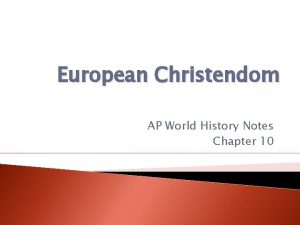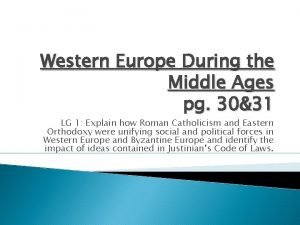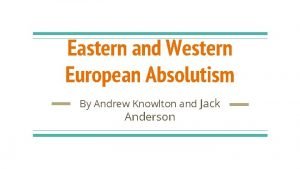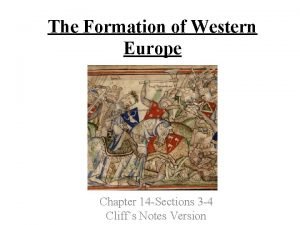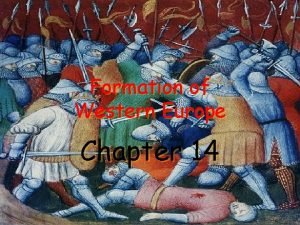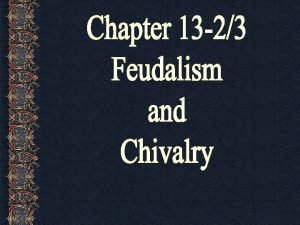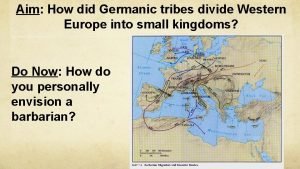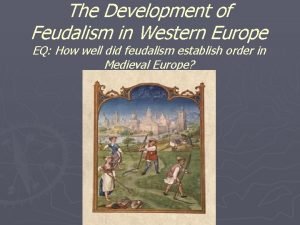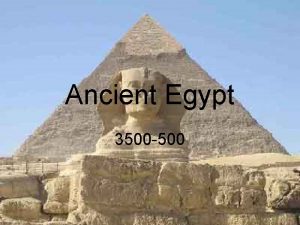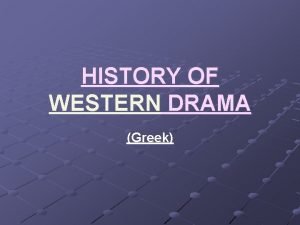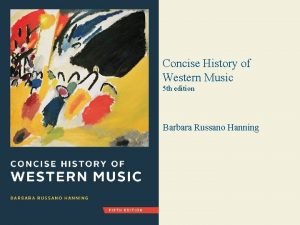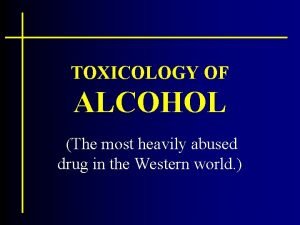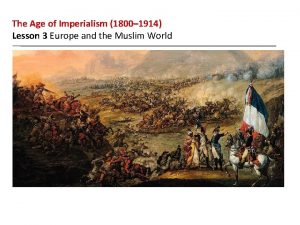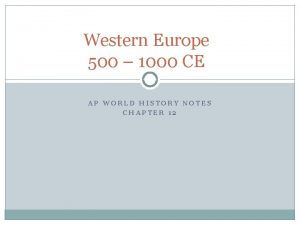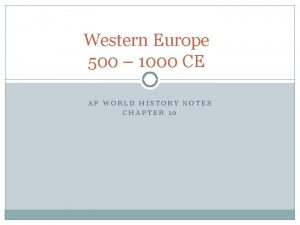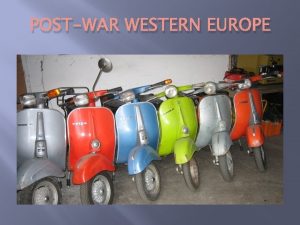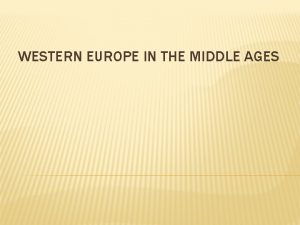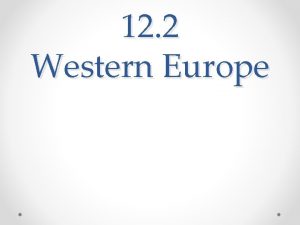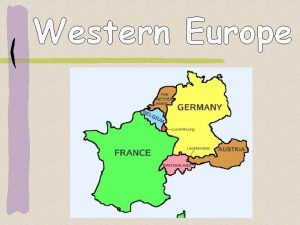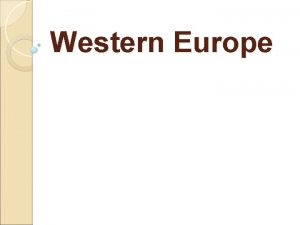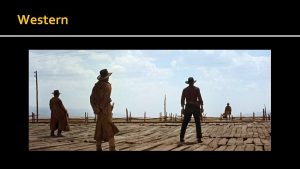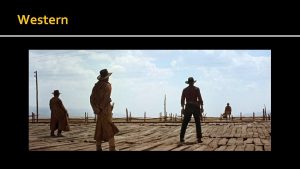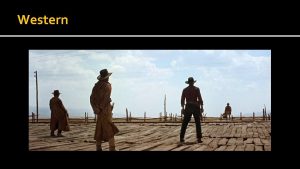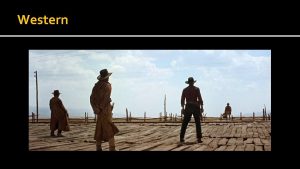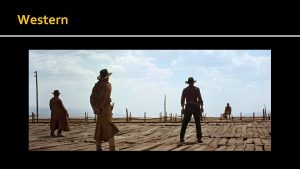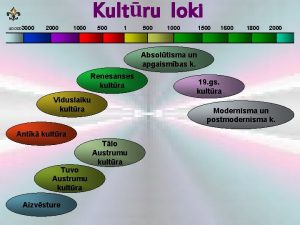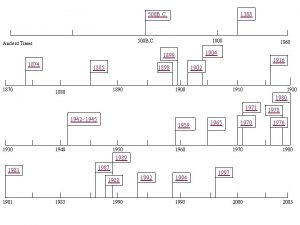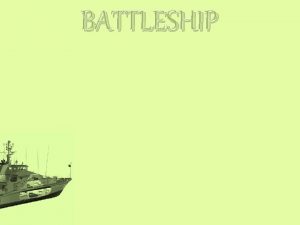Western Europe 500 1000 CE AP WORLD HISTORY






















- Slides: 22

Western Europe 500 – 1000 CE AP WORLD HISTORY NOTES CHAPTER 10

Political Life in Western Europe �Western Europe = now a series of regional kingdoms instead of one united empire �Many Germanic rulers were influenced by and embraced Roman culture �Many leaders wanted to recreate that unity that existed with the Roman Empire

Charlemagne �Ruled the Carolingian Empire from 768 to 814 CE �Set up an imperial bureaucracy �Standardized weights and measures �Acted like an old imperial ruler �Christmas Day of 800 CE = he was crowned the “new Roman emperor” by the Pope

Charlemagne �His empire was divided among his sons after his death �Attempt at unity = unsuccessful

Otto I of Saxony �Created the Holy Roman Empire (mostly Germany and its surrounding areas) �Ruled from 936 to 973 �Tried to regain unity in Western Europe just like Charlemagne �Also received title of emperor from the Pope �Unsuccessful

Medieval Europe: Periodization Early Middle Ages: 500 – 1000 High Middle Ages: 1000 – 1250 Late Middle Ages: 1250 - 1500

A New Political System �These new kingdoms = created a highly fragmented and decentralized society Europe full of thousands of independent and isolated manors (estates) �Gave rise to a new system in Europe = feudalism = a political, economic, and social system based on loyalty and military service

A New Political System �Power = exercised by monarchs and elite landowning lords �Lesser lords and knights swore allegiance to greater lords and kings Lesser lords = vassals = people who entered into a mutual obligation to a higher lord or monarch Gave them: military protection and support In return they got: land or fiefs Fiefs = estates that came with serfs to work the land

Feudalism

Medieval Knights

A Medieval Castle

Parts of a Medieval Castle

Life of the Nobility �Nobility consisted of lords, ladies, and knights �A lord had almost total authority over his fief �A lady had few, if any, rights �For entertainment, tournaments were held Mock battles between knights

Life of the Nobility �Other entertainment = archery, big dinners, minstrels, and singers

Becoming a Knight… �Boys became knights by: Starting as a page (assistant) to the lord at age 7 At 15, he became a squire who assisted a knight Once he proved himself in battle, he was knighted in a ceremony

Becoming a Knight… �Knights’ behavior was governed by a code of chivalry This became the basis for good manners in western society

The Manorial System �Peasants lived on & worked the lord’s land �This agricultural economic system is known as manorialism �In return for the lord’s protection, the peasants provided services for the lord Farming, herding, weapon making, etc. �Most peasants were serfs = people who couldn’t leave the lord’s manor without permission

Serfs vs. Slaves �Serfs = tied to the land; not the personal property of a specific person �Slaves = belong to their master

The Medieval Manor

Christianity of Western Europe �Roman Catholicism �How did it spread throughout Western Europe? Church leaders and missionaries used a “top-down” strategy Converted people at the top (kings and higher lords) first then they would persuade those below them to convert as well Many kings & lords chose to convert because: they liked the Church’s connection to the “civilized” and “grand” Roman Empire

Christianity of Western Europe �Church authorities also had a lot of political power �They worked together with kings, nobles, and knights Rulers gave the Church: protection and support of the religion The Church gave the rulers: religious legitimacy for their power (“It is the will of the Creator…” �Sometimes they competed for power as well A Church Leader

The Investiture Conflict �Conflict over: who should appoint bishops and the pope himself �The Church? Or kings and emperors? �Compromise = the Church can select its own officials and rulers retain an informal and symbolic role in the process
 Chapter 10 ap world history
Chapter 10 ap world history 100+200+300+400+500+600+700+800+900
100+200+300+400+500+600+700+800+900 Western uplands europe map
Western uplands europe map Who was the leader of the franks
Who was the leader of the franks Andrew knowlton
Andrew knowlton Chapter 14 the formation of western europe
Chapter 14 the formation of western europe Chapter 14 the formation of western europe
Chapter 14 the formation of western europe Total population of europe
Total population of europe Invaders attack western europe
Invaders attack western europe Feudalism
Feudalism The development of feudalism in western europe
The development of feudalism in western europe Western europe hdi
Western europe hdi 3500/500
3500/500 Ap world history chapter 25 africa and the atlantic world
Ap world history chapter 25 africa and the atlantic world Countries michael jackson visited
Countries michael jackson visited History of the western genre
History of the western genre History of western drama
History of western drama Concise history of western music 5th edition
Concise history of western music 5th edition Origin of western theatre
Origin of western theatre Dramaturgy definition theatre
Dramaturgy definition theatre History of typography
History of typography In western countries the most heavily abused drug(s) is/are
In western countries the most heavily abused drug(s) is/are Lesson 3 europe in the muslim world
Lesson 3 europe in the muslim world
